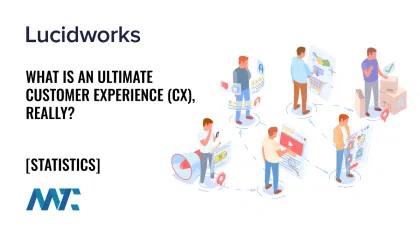What Is An Ultimate Customer Experience (CX), Really?

Customer experience encompasses the entire journey a customer undertakes with a brand, spanning from awareness to consideration, purchase, usage, support, and even advocacy. It encompasses every interaction or touchpoint, both direct and indirect: seeing an ad or hearing about you, visiting your website, making a purchase, using the product or service, seeking help when needed, reading documentation or tutorials, renewing or upgrading, and possibly recommending you to others.
Many companies confuse customer service with customer experience, but they’re not the same. Customer service is one component — often reactive support. CX is broader, encompassing proactive, anticipatory, emotional, and frequently multifaceted aspects, usually shaped across multiple channels. For B2C, this might mean having good documentation, an easy onboarding process, helpful self-service options, and ongoing support. For B2B, it includes the onboarding process, user interfaces (UI/UX), transparency, communication, training or coaching, continuing execution, and value delivery.
The Modern Imperative: Why CX Matters More Than Ever
Businesses throughout the world lose a combined $3.7 trillion annually due to poor customer experiences. And companies with better customer experiences grow revenue 5.1× faster than competitors with poor customer experiences.
Lucidworks
In lean economic times, customers have less tolerance for friction, poor experiences, or brands that don’t meet expectations. Loyalty is fragile: switching costs are lower, alternatives are numerous, and negative experiences are amplified (via social media and reviews). To survive and thrive, companies must deliver across all touchpoints, well beyond just product and customer service.
Components of an Ultimate Customer Experience
52% of consumers state that support interactions leave them exhausted, and 55% feel increasingly stressed.
Lucidworks
Here are the key components you need to get right. Each is vital; neglecting one tends to degrade the whole.
- Awareness & First Impressions: How customers discover you — marketing, word of mouth (WOM), ads, referrals. What they see about you (website, content, reviews) sets expectations. If the promise is strong, but follow-through is weak, trust is lost early.
- Ease of Consideration and Purchase: Clear information, transparent pricing, easy checkout. The fewer friction points, the better. For B2B: clear demos, proof of value, trials, or pilot periods.
- Onboarding1 do they get up and running? Good onboarding involves clear instructions, helpful documentation, and possibly a video or coaching. For software: UX that guides new users, in-product help, maybe mentor or customer success roles.
- Usage, Continuous Value, and Support: As customers use your product/service, the interaction must stay smooth. Support must be responsive, knowledgeable, and available across multiple channels—documentation, tutorials, and training. For B2B, consider periodic reviews, strategy sessions, and the flexibility to adapt. For B2C, community forums, FAQs, and self-service.
- Emotional / Human Touch & Personalization: It’s not just technical correctness. It’s about feeling heard, feeling valued, and knowing that the brand understands me through personalization (without crossing into creepy), empathetic communication, anticipating my needs, and making me feel confident.
- Consistency Across Channels and Time: The experience must be seamless whether someone is on your website, in your app, talking to support, or reading docs. Messages and tone should align. Promises in marketing need to match actual product behavior. Over time, cumulative quality counts.
- Feedback, Adaptation, Continuous Improvement: Collect feedback proactively (through surveys, social media, and support tickets), analyze the data, and iterate. Fix recurring pain points. Be prepared to evolve UX, communication, onboarding, and other key areas. Utilize metrics such as NPS (Net Promoter Score), churn rate, customer retention, time to resolution, and customer satisfaction.
- Post-Purchase1referral incentives. Empower customers to become advocates. Make them feel part of your community.
How AI Is Reshaping Customer Experience
Personalization powered by AI can lead to a 20-30% increase in conversion rates and a 15-20% improvement in customer satisfaction. 84% of customer service representatives using AI report that it makes responding to tickets easier.
Lucidworks
AI isn’t just a tool for automation; it’s changing what’s possible for CX in fundamental ways:
- Personalization at scale: AI can analyze massive datasets of customer behavior to predict preferences, suggest relevant products or content, tailor UI, and even anticipate needs.
- Conversational AI / Chatbots with Emotional Intelligence: Not just answering FAQs, but detecting sentiment (frustration, confusion), adjusting tone, escalating appropriately. AI voice recognition and NLP help make support feel more natural.
- Faster Response, 24/7 Support: AI chatbots, virtual assistants, and self-service tools let companies be “on” when humans aren’t. This is becoming expected, not optional.
- 1 Using unified data platforms ensures that every touchpoint has the same baseline information (customer history, preferences).
- Balancing Personalization with Privacy & Ethical AI Practices: As personalization increases, so do concerns about misuse of data or creepy invasions. Brands that are transparent, respectful, and compliant will earn more trust.
AI also helps streamline internal operations by automating repetitive tasks, freeing up human agents for higher-value interactions, using sentiment analysis to identify systemic issues, and generating content (tutorials, documentation) to scale educational resources, among other benefits.
The Pressure Cooker: Lean Times & Customer Loyalty
Economic downturns, inflation, and budget constraints — these put extra pressure on both companies and customers. Here’s how that impacts CX:
- Lower tolerance for subpar 1. One bad experience may be enough to lose them entirely.
- Competition everywhere: Barriers to switching are lower; choices are more plentiful. If you don’t deliver value and delight from start to finish, customers will try someone else.
- Demand for more value and transparency: Pricing, performance, post-sale support — all under scrutiny. Hidden fees, unclear terms, or oversold promises are red flags. Strong CX can differentiate.
- Retention over acquisition: Acquiring new customers becomes more expensive/uncertain. So keeping existing customers — making sure they renew, expand, refer — becomes more strategic.
- Cost pressure 1 support, community programs, or customer success teams — but those are precisely the areas that matter most now. AI helps here, but only if properly implemented. Missteps (e.g., generic bots, poor escalation paths) can backfire.
Customer Experience Trends & Stats
Here are key data points from that Lucidworks trends piece that underscore what’s happening now and what’s coming:
- AI: Only 25% of AI projects launched in 2024 have been successful / brought into full operation / achieved scale.
- Digital Experiences: 80% of customers say a seamless digital experience is as necessary as the product or service itself.
- Marketing Messages: 72% of customers say they only engage with marketing messages tailored to their interests.
- Customer Interactions: By 2025, over 80% of customer interactions are expected to be handled by AI chatbots.
- Personalization: AI can lead to a 20-30% increase in conversion rates and a 15-20% improvement in customer satisfaction.
- Privacy: 84% of software consumers say data privacy is one of the most essential features in purchasing new software.
These emphasize that customers are expecting more: faster, unified, personalized, yet private interactions. Brands that don’t move will fall behind.
How to Build the Ultimate CX: Practical Steps
Putting all this together, here’s a roadmap for companies that want to deliver world-class customer experience.
- Map the Entire Customer Journey: Don’t just map post-purchase or support. Include awareness, discovery, purchase, onboarding, usage, potential problems, renewal or repeat purchase, and advocacy. Identify every touchpoint. Understand what customers feel, think, and need at each step (pain points, emotions, expectations).
- Set Clear CX Metrics: Define what good looks like. Possible metrics: Net Promoter Score (NPS), Customer Satisfaction (CSAT), Customer Effort Score (CES), churn / retention, time to resolution, first contact resolution, usage/adoption rates, support ticket sentiment. Use these as both baseline and ongoing measurement.
- Invest in Data + Unified Systems: Centralize customer data (purchase history, support history, behavior, preferences). Break down silos so information flows across marketing, support, product, and sales. This helps personalize and anticipate, as well as enabling real-time adjustments.
- Adopt AI Thoughtfully: Use AI where it helps most — e.g. conversational agents for common queries; recommendation systems; predictive analytics; automation of repetitive tasks; sentiment analysis; content generation (tutorials, knowledge base). However, ensure you have governance, oversight, escalation paths, fallback to humans, data privacy, and other necessary measures in place.
- Design for Empathy and Personalization: Train teams to understand not just what customers want, but how they feel. Utilize UI/UX best practices to ensure that support communications are humanized, allowing customers to control or set their preferences (tone, channel, and frequency). Personalize content and interactions based on customer behavior and preferences.
- Ensure 1messaging apps, their experience should feel coherent. They shouldn’t need to re-explain, discover where things are, or feel stuck when switching channels.
- Handle Onboarding and Usage Well: First experiences matter a lot. Make onboarding frictionless: clear steps, guides, proactive outreach. Ensure usage is smooth: good UX, reliable performance, available help. For B2B especially, ensure the customer success function is strong: regular check-ins, training, hearing feedback, and anticipating issues.
- Close the Loop on Feedback: Gather feedback continuously through surveys, usage analytics, support ticket content, and social listening. More importantly: act on feedback. Let customers know you heard them (updates, changes). Iteration is essential.
- Build Advocacy & Loyalty Satisfaction: Alone isn’t enough. Encourage referrals, create a sense of community, and reward loyalty. Make it easy for customers to share. Recognize loyal users. Use storytelling, case studies, and reviews. Happy customers who tell others are a powerful force.
- Maintain Ethical Standards and Trust: Be transparent about how you use customer data and what AI does behind the scenes. Prioritize privacy and security. Mitigate biases in AI systems. Let customers understand and control how they’re being known. Trust is fragile.
Customer Experience Case Examples
To make this more concrete, here are a couple of scenarios:
B2C CX
A B2C e-commerce brand might use AI to send personalized welcome emails post-purchase with how-to content, utilize chatbots for 24/7 support, optimize mobile-first shopping experiences, and offer human support escalation and transparent shipping/tracking. Their loyalty is strengthened because customers feel guided and cared for, not just because they have paid.
B2B CX
A B2B SaaS company might have robust onboarding (dedicated customer success managers), in-product tooltips, regular check-ins, usage analytics to predict and head off at-risk customers, integrating support chat embedded in the UI, giving customers access to a knowledge base (KB), documentation, training webinars, etc., and using AI to automate routine support while reserving human time for strategic conversations.
Getting Started: What to Do Now
If you’re looking to upgrade your CX, here’s a short action plan to kick off:
- Audit your current journey: map all customer touchpoints, collect feedback, identify strengths & gaps.
- Prioritize: choose the top pain points — ones that most degrade the experience or risk losing customers.
- Build team alignment: gain buy-in across marketing, product, support, and sales — CX is a cross-functional team.
- Invest in the proper data infrastructure and AI tools, accompanied by clear metrics and robust governance.
- Pilot improvements: consider a better onboarding flow, a chatbot for low-complexity support, or personalized recommendations. Measure impact.
- Scale what works, keeping human empathy front and center, and maintaining trust & transparency.
The ultimate customer experience is holistic: awareness through advocacy, purchase through usage, service through surprise. In today’s climate—where customers have more choices, lower tolerance for friction, and stronger expectations—delivering good CX isn’t optional. It’s a strategic imperative. AI offers powerful tools to personalize, speed up, anticipate, and empathize. However, misusing it, ignoring privacy, or neglecting human elements can have unintended consequences. The brands that succeed will be those that combine technological excellence with human connection.
Start transforming your customer experience now — audit your journey, embrace empathy, harness AI with care. Don’t let the competition win on experience.







